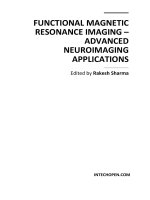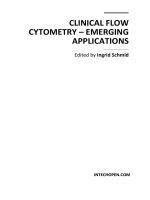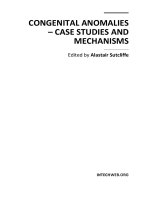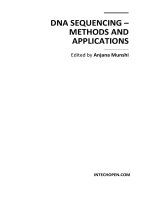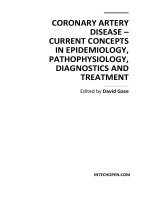DNA Sequencing – Methods and Applications Edited by Anjana Munshi pptx
Bạn đang xem bản rút gọn của tài liệu. Xem và tải ngay bản đầy đủ của tài liệu tại đây (4.01 MB, 184 trang )
DNA SEQUENCING –
METHODS AND
APPLICATIONS
Edited by Anjana Munshi
DNA Sequencing – Methods and Applications
Edited by Anjana Munshi
Published by InTech
Janeza Trdine 9, 51000 Rijeka, Croatia
Copyright © 2012 InTech
All chapters are Open Access distributed under the Creative Commons Attribution 3.0
license, which allows users to download, copy and build upon published articles even for
commercial purposes, as long as the author and publisher are properly credited, which
ensures maximum dissemination and a wider impact of our publications. After this work
has been published by InTech, authors have the right to republish it, in whole or part, in
any publication of which they are the author, and to make other personal use of the
work. Any republication, referencing or personal use of the work must explicitly identify
the original source.
As for readers, this license allows users to download, copy and build upon published
chapters even for commercial purposes, as long as the author and publisher are properly
credited, which ensures maximum dissemination and a wider impact of our publications.
Notice
Statements and opinions expressed in the chapters are these of the individual contributors
and not necessarily those of the editors or publisher. No responsibility is accepted for the
accuracy of information contained in the published chapters. The publisher assumes no
responsibility for any damage or injury to persons or property arising out of the use of any
materials, instructions, methods or ideas contained in the book.
Publishing Process Manager Bojan Rafaj
Technical Editor Teodora Smiljanic
Cover Designer InTech Design Team
First published April, 2012
Printed in Croatia
A free online edition of this book is available at www.intechopen.com
Additional hard copies can be obtained from
DNA Sequencing – Methods and Applications, Edited by Anjana Munshi
p. cm.
ISBN 978-953-51-0564-0
Contents
Preface VII
Section 1 Methods of DNA Sequencing 1
Chapter 1 DNA Representation 3
Bharti Rajendra Kumar
Chapter 2 Hot Start 7-Deaza-dGTP Improves Sanger
Dideoxy Sequencing Data of GC-Rich Targets 15
Sabrina Shore, Elena Hidalgo Ashrafi and Natasha Paul
Section 2 Applications of DNA Sequencing 33
Chapter 3 Sequencing Technologies and
Their Use in Plant Biotechnology and Breeding 35
Victor Llaca
Chapter 4 DNA Sequencing and Crop Protection 61
Rosemarie Tedeschi
Chapter 5 Improvement of
Farm Animal Breeding by DNA Sequencing 85
G. Darshan Raj
Chapter 6 The Input of DNA Sequences to
Animal Systematics: Rodents as Study Cases 103
Laurent Granjon and Claudine Montgelard
Chapter 7 The Application of
Pooled DNA Sequencing in Disease Association Study 141
Chang-Yun Lin and Tao Wang
Chapter 8 Nucleic Acid Aptamers as Molecular Tags for
Omics Analyses Involving Sequencing 157
Masayasu Kuwahara and Naoki Sugimoto
Preface
More than a quarter of a century earlier the story of DNA sequencing began when
Sanger’s studies of insulin first demonstrated the importance of sequence in biological
macromolecules. Although two different DNA sequencing methods have been
developed during the same period, Sanger’s dideoxy chain-termination sequencing
method has became the method of choice over the Maxam–Gilbert method. The
complete sequence of oX-174 was published in 1977 and then revised slightly in the
following year by dideoxy method. It demonstrated that the DNA sequence could tell
a fascinating story based upon the interpretation of the sequence in terms of the
genetic code. Recently several next generation high throughput DNA sequencing
techniques have arrived on the scene and are opening fascinating opportunities in the
fields of biology and medicine.
This book, “DNA Sequencing - Methods and Applications” illustrates methods of DNA
sequencing and its application in plant, animal and medical sciences. This book has two
distinct sections. The first one includes 2 chapters devoted to the DNA sequencing
methods and the second one includes 6 chapters focusing on various applications of this
technology. The content of the articles presented in the book is guided by the knowledge
and experience of the contributing authors. This book is intended to serve as an
important resource and review to the researchers in the field of DNA sequencing.
An overview of DNA sequencing technologies right from the Sanger’s method to the
next generation high throughput DNA sequencing techniques including massively
parallel signature sequencing, polony sequencing, pyrosequencing, Illumina
Sequencing, SOLiD sequencing etc. has been presented in chapter 1. Chapter 2 reviews
how Hot Start-7-deaza-dGTP improves Sanger’s dideoxy sequencing data of GC rich
template DNA.
Chapter 3 demonstrates how the use of sequencing methods in combination with
strategies in breeding and molecular genetic modifications has contributed to our
knowledge of plant genetics and remarkable increase in agricultural productivity.
Chapter 4 provides information on applications of DNA sequencing in crop
protection. This chapter highlights the perspectives for new sustainable and
environmental friendly strategies for controlling pests and diseases of crop plants.
VIII Preface
Chapter 5 has discussed the application of DNA sequencing in improving the
breeding strategies of farm animals. The development of molecular markers using
DNA sequencing serves as an underlying tool, for geneticists and breeders to create
desirable farm animals.
Chapter 6 aims at showing how DNA sequencing technology has reboosted rodent
systematics leading to a much better supported classification of this order. The
molecular data generated by DNA sequencing has played an important role in rodent
systematics over the last decades indicating the importance of this kind of information
in evolutionary biology as a whole.
Chapter 7 has discussed the application of pooled DNA sequencing in disease
association studies. It is a cost effective strategy for genome-wide association studies
(GWAS) and successfully identifies hundreds of variants associated with complex
traits. Some strategies of pooling design including PI- deconvolution shifted-
transversal design, multiplex scheme and overlapping pools to recover linkage
disequilibrium information have also been introduced. Statistical methods for the
detection of variants and case-control association studies accounting for high levels of
sequencing errors have been discussed.
Chapter 8 focuses on the development of nucleic acid-aptamers and the outlook for
related technologies. Aptamers can be readily amplified by PCR and decoded by
sequencing and it is possible to apply them as molecular tags to quantitative
bimolecular analysis and single cell analysis.
The scientific usefulness of DNA sequencing continues to be proven, and the number
of sequenced and catalogued genomes has grown more than five times from where it
was at the middle of the decade.
Anjana Munshi
Department of Molecular Biology,
Institute of Genetics and Hospital for Genetic Diseases, Hyderabad,
India
Section 1
Methods of DNA Sequencing
1
DNA Representation
Bharti Rajendra Kumar
B.T. Kumaon Institute of Technology, Dwarahat,Almora, Uttarakhand,
India
1. Introduction
The term DNA sequencing refers to methods for determining the order of the nucleotides
bases adenine,guanine,cytosine and thymine in a molecule of DNA. The first DNA sequence
were obtained by academic researchers,using laboratories methods based on 2- dimensional
chromatography in the early 1970s. By the development of dye based sequencing method
with automated analysis,DNA sequencing has become easier and faster. The knowledge of
DNA sequences of genes and other parts of the genome of organisms has become
indispensable for basic research studying biological processes, as well as in applied fields
such as diagnostic or forensic research.
DNA is the information store that ultimately dictates the structure of every gene product,
delineates every part of the organisms. The order of the bases along DNA contains the
complete set of instructions that make up the genetic inheritance.
The rapid speed of sequencing attained with modern DNA sequencing technology has been
instrumental in the sequencing of the human genome, in the human genome project.
Fig. 1. DNA Sequence Trace
DNA can be sequenced by a chemical procedure that breaks a terminally labelled DNA
molecule partially at each repetition of a base. The length of the labelled fragments then
identify the position of that base. We describe reactions that cleave DNA preferentially at
guanines,at adenines,at cytosine and thymines equally, and at cytosine alone. When the
product of these four reactions are resolved by size,by electrophoresis on a polyacrylamide
gel, the DNA sequences can be read from the pattern of radioactive bands. The technique
DNA Sequencing – Methods and Applications
4
will permit sequencing of atleast 100 bases from the point of labelling. The purine specific
reagent is dimethyl sulphate; and the pyrimidine specific reagent is hydrazine.
In 1973 , Gilbert and Maxam reported the sequence of 24 base pairs using a method known
as wandering- spot analysis.
The chain termination method developed by Sanger and coworkers in 1975 owing to its
relative easy and reliability.
In 1975 the first complete DNA genome to be sequenced is that of bacteriophage X174.
By knowing the DNA sequence, the cause of the various diseases can be known. We can
determine the sequence responsible for various disease and can be treated with the help of
Gene therapy.
DNA sequencing is very significant in research and forensic science. The main objective of
DNA sequence generation method is to evaluate the sequencing with very high accuracy
and reliability.
There are some common automated DNA sequencing problems :-
1. Failure of the DNA sequence reaction.
2. Mixed signal in the trace ( multiple peaks).
3. Short read lengths and poor quality data.
4. Excessive free dye peaks “dye blobs” in the trace.
5. Primer dimer formation in sequence reaction
6. DNA polymerase slippage on the template mononucleotide regions.
So, we should have to do the sequencing in such a manner to avoid or minimize these
problems.
DNA sequencing can solve a lot of problems and perform a lot of work for human wellfare
A sequencing can be done by different methods :
1. Maxam – Gilbert sequencing
2. Chain-termination methods
3. Dye-terminator sequencing
4. Automation and sample preperation
5. Large scale sequencing strategies
6. New sequencing methods.
2. Maxam-Gilbert sequencing
In 1976-1977, Allan Maxam and Walter Gilbert developed a DNA sequencing method based
on chemical modification of DNA and subsequent cleavage at specific bases.
The method requires radioactive labelling at one end and purification of the DNA fragment
to be sequenced. Chemical treatment generates breaks at a small proportions of one or two
of the four nucleotide based in each of four reactions (G,A+G, C, C+T). Thus a series of
labelled fragments is generated,from the radiolabelled end to the first ‘cut’ site in each
molecule. The fragments in the four reactions are arranged side by side in gel
DNA Representation
5
electrophoresis for size separation. To visualize the fragments,the gel is exposed to X-ray
film for autoradiography,yielding a series of dark bands each corresponding to a
radiolabelled DNA fragment,from which the sequence may be inferred.
3. Chain-termination method
The chain terminator method is more efficient and uses fewer toxic chemicals and lower
amount of radioactivity than the method of Maxam and Gilbert.
The key principle of the Sanger method was the use of dideoxynucleotide triphosphates
(ddNTPs) as DNA chain terminators.
The chain termination method requires a single-stranded DNA template,a DNA primer,a DNA
polymerase, radioactively or fluorescently labelled nucleotides,and modified nucleotides that
terminate DNA strand elongation. The DNA sample is divided into four separate sequencing
reactions,containing all four of the standard deoxynucleotides(dATP, dGTP, dCTP, dTTP) and
the DNA polymerase. To each reaction is added only one of the four dideoxynucleotide
(ddATP, ddGTP, ddCTP, ddTTP) which are the chain terminating nucleotides, lacking a 3’-OH
group required for the formation of a phosphodiester bond between two nucleotides,thus
terminating DNA strand extension and resulting in DNA fragments of varying length.
Fig. 2. Part of a radioactively labelled sequencing gel
The newly synthesized and labelled DNA fragments are heat denatured , and separated by
size by gel electrophoresis on a denaturing polyacrylamide-urea gel with each of the four
reactions run in one of the four individual lanes(lanes A, T, G,C), the DNA bands are then
visualized by autoradiography or UV light,and the DNA sequence can be directly read off
DNA Sequencing – Methods and Applications
6
the X-ray film or gel image. A dark band in a lane indicates a DNA fragment that is result of
chain termination after incorporation of a dideoxynucleotide (ddATP, ddGTP, ddCTP, or
ddTTP). The relative position of the different bands among the four lanes are then used to
read (from bottom to top) the DNA sequence.
The technical variations of chain termination sequencing include tagging with nucleotides
containing radioactive phosphorus for labelling, or using a primer labelled at the 5’ end with
a fluorescent dye. Dye- primer sequencing facilitates reading in an optical system for faster
and more economical analysis and automation.
Chain termination methods have greatly simplified DNA sequencing. Limitations include
non-specific binding of the primer to the DNA,affecting accurate read-out of the DNA
sequence,and DNA secondary structures affecting the fidelity of the sequence.
3.1 Dye-terminator sequencing
Dye-terminator sequencing utilizes labelling of the chain terminator ddNTPs,which permits
sequencing in a single reaction,rather than four reactions as in the labelled- primer method.
In dye- terminator sequencing ,each of the four dideoxynucleotide chain terminators is
labelled with fluorescent dyes,each of which with different wavelengths of fluorescence and
emission. Owing to its greater expediency and speed,dye terminator sequencing is now the
mainstay in automated sequencing. Its limitation include dye effects due to differences in
the incorporation of the dye-labelled chain terminators into the DNA fragment,resulting in
unequal peak heights and shapes in the electronic DNA sequence trace chromatogram.
The common challenges of DNA sequencing include poor quality in the first 15-40 bases of
the sequence and deteriorating quality of sequencing traces after 700-900 bases.
Fig. 3. Sequence ladder by radioactive sequencing compared to fluorescent peaks
DNA Representation
7
3.2 Automation and sample preparation
Automated DNA sequencing instruments (DNA sequencers) can sequence upto 384 DNA
samples in a single batch (run) in up to 24 runs a day. DNA sequencers carry out capillary
electrophoresis for size seperation,detection and recording of dye fluorescence,and data
output as fluorescent peak trace chromatograms.
A number of commercial and non-commercial software packages can trim low-quality DNA
traces automatically. These programmes score the quality of each peak and remove low-
quality base peaks (generally located at the ends of the sequence).
Fig. 4. View of the start of an example dye-terminator read
4. Large-scale sequencing strategies
Current methods can directly sequence only relative short (300-1000 nucleotides long) DNA
fragments in a single reaction. The main obstacle to sequencing DNA fragments above this
size limit is insufficient power of separation for resolving large DNA fragments that differ in
length by only one nucleotide.
Large scale sequencing aims at sequencing very long DNA pieces,such as whole
chromosomes. It consist of cutting (with restriction enzymes)or shearing (with mechanical
forces) large DNA fragments into shorter DNA fragments. The fragmented DNA is cloned
into a DNA vector, and amplified in E.coli. Short DNA fragments purified from individual
bacterial colonies are individually sequenced and assembled electronically into one
long,contiguous sequence. This method does not require any pre- existing information
about the sequence of the DNA and is reffered to as de novo sequencing. Gaps in the
assembled sequence may be filled by primer walking. The different strategies have different
tradeoffs in speed and accuracy.
DNA Sequencing – Methods and Applications
8
Fig. 5. Genomic DNA is fragmented into random pieces and cloned as a bacterial library.
DNA from individual bacterial clones is sequenced and the sequence is assembled by using
overlapping regions.
5. New sequencing methods
The high demand for low-cost sequencing has driven the development of high- throughput
sequencing technologies that parallelize the sequencing process,producing thousands or
millions of sequences at once. High-throughput sequencing technologies are intended to
lower the cost of DNA sequencing .
Molecular detection method are not sensitive enough for single molecule sequencing, so
most approaches use an in vitro cloning step to amplify individual DNA molecules.
In microfluidic Sanger sequencing the entire thermocycling amplification of DNA fragments
as well as their separation by electrophoresis is done on a single chip (appoximately 100cm
in diameter) thus reducing the reagent usage as well as cost. In some instances researchers
have shown that they can increase the throughput of conventional sequencing through the
use of microchips.
6. High throughput sequencing
The high demand for low-cost sequencing has driven the development of high-throughput
sequencing technologies that parallelize the sequencing process, producing thousands or
millions of sequences at once. High-throughput sequencing technologies are intended to
lower the cost of DNA sequencing beyond what is possible with standard dye-terminator
methods.
DNA Representation
9
6.1 Lynx therapeutics' massively parallel signature sequencing (MPSS)
The first of the "next-generation" sequencing technologies, MPSS was developed in the 1990s
at Lynx Therapeutics, a company founded in 1992 by Sydney Brenner and Sam Eletr. MPSS
is an ultra high throughput sequencing technology. When applied to expression profile, it
reveal almost every transcript in the sample and provide its accurate expression level.
MPSS was a bead-based method that used a complex approach of adapter ligation followed
by adapter decoding, reading the sequence in increments of four nucleotides; this method
made it susceptible to sequence-specific bias or loss of specific sequences. However, the
essential properties of the MPSS output were typical of later "next-gen" data types, including
hundreds of thousands of short DNA sequences. In the case of MPSS, these were typically
used for sequencing cDNA for measurements of gene expression levels. Lynx Therapeutics
merged with Solexa in 2004, and this company was later purchased by Illumina.
6.2 Polony sequencing
It is an inexpensive but highly accurate multiplex sequencing technique that can be used to
read millions of immobilized DNA sequences in parallel. This techniques was first
developed by Dr. George Church in Harvard Medical college. It combined an in vitro
paired-tag library with emulsion PCR, an automated microscope, and ligation-based
sequencing chemistry to sequence an E. coli genome at an accuracy of > 99.9999% and a cost
approximately 1/10 that of Sanger sequencing.
6.3 Pyrosequencing
A parallelized version of pyrosequencing was developed by 454 Life Sciences, which has
since been acquired by Roche Diagnostics. The method amplifies DNA inside water droplets
in an oil solution (emulsion PCR), with each droplet containing a single DNA template
attached to a single primer-coated bead that then forms a clonal colony. The sequencing
machine contains many picolitre-volume wells each containing a single bead and
sequencing enzymes. Pyrosequencing uses luciferase to generate light for detection of the
individual nucleotides added to the nascent DNA, and the combined data are used to
generate sequence read-outs.This technology provides intermediate read length and price
per base compared to Sanger sequencing on one end and Solexa and SOLiD on the other.
6.4 Illumina (Solexa) sequencing
Solexa developed a sequencing technology based on dye terminators. In this, DNA molecule
are first attached to primers on a slide and amplified, this is known as bridge amplification.
Unlike pyrosequencing, the DNA can only be extended one neucleotode at a time. A camera
takes images of the fluorescently labeled nucleotides, then the dye along with the terminal 3'
blocker is chemically removed from the DNA, allowing the next cycle.
6.5 SOLiD sequencing
The technology for sequencing used in ABISolid sequencing is oligonucleotide ligation and
detection. In this, a pool of all possible oligonucleotides of fixed length are labelled
according to the sequenced position. This sequencing results to the sequences of quantities
and lengths comparable to illumine sequencing.
DNA Sequencing – Methods and Applications
10
6.6 DNA nanoball sequencing
It is high throughput sequencing technology that is used to determine the entire genomic
sequence of an organisms. The method uses rolling circle replication to amplify fragments of
genomic DNA molecules. This DNA sequencing allows large number of DNA nanoballs to
be sequenced per run and at low reagent cost compared to other next generation sequencing
platforms. However, only short sequences of DNA are determined from each DNA nanoball
which makes mapping the short reads to a reference genome difficult. This technology has
been used for multiple genome sequencing projects and is scheduled to be used for more.
6.7 Helioscope(TM) single molecule sequencing
Helioscope sequencing uses DNA fragments with added polyA tail adapters, which are
attached to the flow cell surface. The next steps involve extension-based sequencing with
cyclic washes of the flow cell with fluorescently labeled nucleotides. The reads are
performed by the Helioscope sequencer. The reads are short, up to 55 bases per run, but
recent improvemend of the methodology allowes more accurate reads of homopolymers
and RNA sequencing.
6.8 Single molecule SMRT(TM) sequencing
SMRT sequencing is based on the sequencing by synthesis approach. The DNA is synthesisd
in so calles zero-mode wave-guides (ZMWs) - small well-like containers with the capturing
tools located at the bottom of the well. The sequencing is performed with use of unmodified
polymerase and fluorescently labelled nucleotides flowing freely in the solution. The wells
are constructed in a way that only the fluorescence occurring by the bottom of the well is
detected. The fluorescent label is detached from the nucleotide at its incorporation into the
DNA strand, leaving an unmodified DNA strand. The SMTR technology allows detection of
nucleotide modifications. This happens through the observation of polymerase kinetics. This
approach allows reads of 1000 nucleotides.
6.9 Single molecule real time (RNAP) sequencing
This method is based on RNA polymerase (RNAP), which is attached to a polystyrene bead,
with distal end of sequenced DNA is attached to another bead, with both beads being
placed in optical traps. RNAP motion during transcription brings the beads in closer and
their relative distance changes, which can then be recorded at a single nucleotide resolution.
The sequence is deduced based on the four readouts with lowered concentrations of each of
the four nucleotide types.
7. Other sequencing technologies
Sequencing by hybridization is a non-enzymatic method that uses a DNA microarray. A
single pool of DNA whose sequence is to be determined is fluorescently labelled and
hybridized to an array containing known sequences. Strong hybridization signals from a
given spot on the array identifies its sequence in the DNA being sequenced. Mass
spectrometry may be used to determine mass differences between DNA fragments
produced in chain-termination reactions.
DNA Representation
11
Some important applications of DNA sequencing are :
1. To analyse any protein structure and function we must have the knowledge of its
primary structure i.e its DNA sequence.
2. With its study we can understand the function of a specific sequence and the sequence
responsible for any disease.
3. With the help of comparative DNA sequence study we can detect any mutation.
4. Kinship study.
5. DNA fingerprinting.
6. By knowing the whole genome sequence, Human genome project get completed.
The main problem with sequencing is its intactness. If we perform the sequencing of same
sample with different methods the result may be different so we should have to do it in such
a manner that atleast 40-50% sequence must be same of similar sample.
8. Benchmarks in DNA sequencing
1953 Discovery of the structure of the DNA double helix.
1972 Development of recombinant DNA technology, which permits isolation of defined
fragments of DNA; prior to this, the only accessible samples for sequencing were from
bacteriophage or virus DNA.
1975 The first complete DNA genome to be sequenced is that of bacteriophage φX174
1977 Allan Maxam and Walter Gilbert publish "DNA sequencing by chemical
degradation". Fred Sanger, independently, publishes "DNA sequencing by enzymatic
synthesis".
1980 Fred Sanger and Wally Gilbert receive the Nobel Prize in Chemistry
EMBL-bank, the first nucleotide sequence repository, is started at the European
Molecular Biology Laboratory
1982 Genbank starts as a public repository of DNA sequences.
Andre Marion and Sam Eletr from Hewlett Packard start Applied Biosystems in May,
which comes to dominate automated sequencing.
Akiyoshi Wada proposes automated sequencing and gets support to build robots with
help from Hitachi.
1984 Medical Research Council scientists decipher the complete DNA sequence of the
Epstein-Barr virus, 170 kb.
1985 Kary Mullis and colleagues develop the polymerase chain reaction, a technique to
replicate small fragments of DNA
1986 Leroy E. Hood's laboratory at the California Institute of Technology and Smith
announce the first semi-automated DNA sequencing machine.
1987 Applied Biosystems markets first automated sequencing machine, the model ABI
370.
Walter Gilbert leaves the U.S. National Research Council genome panel to start Genome
Corp., with the goal of sequencing and commercializing the data.
1990 The U.S. National Institutes of Health (NIH) begins large-scale sequencing trials
on Mycoplasma capricolum, Escherichia coli, Caenorhabditis elegans, and
Saccharomyces cerevisiae (at 75 cents (US)/base).
DNA Sequencing – Methods and Applications
12
Barry Karger (January), Lloyd Smith (August), and Norman Dovichi (September)
publish on capillary electrophoresis.
1991 Craig Venter develops strategy to find expressed genes with ESTs (Expressed
Sequence Tags).
Uberbacher develops GRAIL, a gene-prediction program.
1992 Craig Venter leaves NIH to set up The Institute for Genomic Research (TIGR).
William Haseltine heads Human Genome Sciences, to commercialize TIGR products.
Wellcome Trust begins participation in the Human Genome Project.
Simon et al. develop BACs (Bacterial Artificial Chromosomes) for cloning.
First chromosome physical maps published:
Page et al. - Y chromosome;
Cohen et al. chromosome 21.
Lander - complete mouse genetic map;
Weissenbach - complete human genetic map.
1993 Wellcome Trust and MRC open Sanger Centre, near Cambridge, UK.
The GenBank database migrates from Los Alamos (DOE) to NCBI (NIH).
1995 Venter, Fraser and Smith publish first sequence of free-living
organism, Haemophilus influenzae (genome size of 1.8 Mb).
Richard Mathies et al. publish on sequencing dyes (PNAS, May).
Michael Reeve and Carl Fuller, thermostable polymerase for sequencing.
1996 International HGP partners agree to release sequence data into public databases
within 24 hours.
International consortium releases genome sequence of yeast S. cerevisiae (genome
size of 12.1 Mb).
Yoshihide Hayashizaki's at RIKEN completes the first set of full-length mouse
cDNAs.
ABI introduces a capillary electrophoresis system, the ABI310 sequence analyzer.
1997 Blattner, Plunkett et al. publish the sequence of E. coli (genome size of 5 Mb)
1998 Phil Green and Brent Ewing of Washington University publish “phred” for
interpreting sequencer data (in use since ‘95).
Venter starts new company “Celera”; “will sequence HG in 3 yrs for $300m.”
Applied Biosystems introduces the 3700 capillary sequencing machine.
Wellcome Trust doubles support for the HGP to $330 million for 1/3 of the
sequencing.
NIH & DOE goal: "working draft" of the human genome by 2001.
Sulston, Waterston et al finish sequence of C. elegans (genome size of 97Mb).
1999 NIH moves up completion date for rough draft, to spring 2000.
NIH launches the mouse genome sequencing project.
First sequence of human chromosome 22 published.
2000 Celera and collaborators sequence fruit fly Drosophila melanogaster (genome size
of 180Mb) - validation of Venter's shotgun method. HGP and Celera debate issues
related to data release.
HGP consortium publishes sequence of chromosome 21.
HGP & Celera jointly announce working drafts of HG sequence, promise joint
publication.
DNA Representation
13
Estimates for the number of genes in the human genome range from 35,000 to
120,000. International consortium completes first plant sequence, Arabidopsis
thaliana(genome size of 125 Mb).
2001 HGP consortium publishes Human Genome Sequence draft in Nature (15 Feb).
Celera publishes the Human Genome sequence.
2005 420,000 VariantSEQr human resequencing primer sequences published on new
NCBI Probe database.
2007 For the first time, a set of closely related species (12 Drosophilidae) are sequenced,
launching the era of phylogenomics.
Craig Venter publishes his full diploid genome: the first human genome to be
sequenced completely.
2008 An international consortium launches The 1000 Genomes Project, aimed to study
human genetic variability.
2008 Leiden University Medical Center scientists decipher the first complete DNA
sequence of a woman.
9. References
[1] Olsvik O, Wahlberg J, Petterson B, et al. (January 1993). "Use of automated sequencing of
polymerase chain reaction-generated amplicons to identify three types of cholera
toxin subunit B in Vibrio cholerae O1 strains". J. Clin. Microbiol. 31 (1): 22–5. PMC
262614.PMID 7678018.
[2] Pettersson E, Lundeberg J, Ahmadian A (February 2009). "Generations of sequencing
technologies". Genomics 93 (2): 105–11. doi:10.1016/j.ygeno.2008.10.003. PMID
18992322.
[3] Min Jou W, Haegeman G, Ysebaert M, Fiers W (May 1972). "Nucleotide sequence of the
gene coding for the bacteriophage MS2 coat protein". Nature 237 (5350): 82–8.
Bibcode1972Natur.237 82J. doi:10.1038/237082a0. PMID 4555447.
[4] Fiers W, Contreras R, Duerinck F, et al (April 1976). "Complete nucleotide sequence of
bacteriophage MS2 RNA: primary and secondary structure of the replicase gene".
Nature260 (5551): 500–7. Bibcode 1976 Natur.260 500F. doi:10.1038/260500a0.PMID
1264203.
[5] Maxam AM, Gilbert W (February 1977). "A new method for sequencing DNA". Proc.
Natl. Acad. Sci. U.S.A. 74 (2): 560–4. Bibcode 1977PNAS 74 560M.doi:10.1073/
pnas.74.2.560. PMC 392330. PMID 265521.
[6] Gilbert, W. DNA sequencing and gene structure. Nobel lecture, 8 December 1980.
[7] Gilbert W, Maxam A (December 1973). "The Nucleotide Sequence of the lac
Operator".Proc. Natl. Acad. Sci. U.S.A. 70 (12): 3581–4. Bibcode
1973PNAS 70.3581G.doi:10.1073/pnas.70.12.3581. PMC 427284. PMID 4587255.
[8] Sanger F, Coulson AR (May 1975). "A rapid method for determining sequences in DNA
by primed synthesis with DNA polymerase". J. Mol. Biol. 94 (3): 441–
8.doi:10.1016/0022-2836(75)90213-2. PMID 1100841.
[9] Sanger F, Nicklen S, Coulson AR (December 1977). "DNA sequencing with chain-terminating
inhibitors". Proc. Natl. Acad. Sci. U.S.A. 74 (12): 5463–7. Bibcode1977PNAS 74.5463S.
doi:10.1073/pnas.74.12.5463. PMC 431765.PMID 271968.
[10] Sanger F. Determination of nucleotide sequences in DNA. Nobel lecture, 8 December 1980.
DNA Sequencing – Methods and Applications
14
[11] 10.Graziano Pesole; Cecilia Saccone (2003). Handbook of comparative genomics:
principles and methodology. New York: Wiley-Liss. pp. 133. ISBN 0-471-39128-X.
[12] Smith LM, Fung S, Hunkapiller MW, Hunkapiller TJ, Hood LE (April 1985). "The
synthesis of oligonucleotides containing an aliphatic amino group at the 5' terminus:
synthesis of fluorescent DNA primers for use in DNA sequence analysis". Nucleic
Acids Res. 13 (7): 2399–412. doi:10.1093/nar/13.7.2399. PMC 341163. PMID 4000959.
[13] Base-calling for next-generation sequencing platforms — Brief Bioinform". Retrieved
2011-02-24.
[14] Murphy, K.; Berg, K.; Eshleman, J. (2005). "Sequencing of genomic DNA by combined
amplification and cycle sequencing reaction". Clinical chemistry 51 (1): 35–
39.doi:10.1373/clinchem.2004.039164. PMID 15514094. edit
[15] Sengupta, D. .; Cookson, B. . (2010). "SeqSharp: A general approach for improving cycle-
sequencing that facilitates a robust one-step combined amplification and
sequencing method". The Journal of molecular diagnostics : JMD 12 (3): 272–
277.doi:10.2353/jmoldx.2010.090134. PMC 2860461. PMID 20203000. edit
[16] Richard Williams, Sergio G Peisajovich, Oliver J Miller, Shlomo Magdassi, Dan S Tawfik,
Andrew D Griffiths (2006). "Amplification of complex gene libraries by emulsion
PCR".Nature methods 3 (7): 545–550. doi:10.1038/nmeth896. PMID 16791213.
[17] Hall N (May 2007). "Advanced sequencing technologies and their wider impact in
microbiology". J. Exp. Biol. 210 (Pt 9): 1518–25. doi:10.1242/jeb.001370.PMID
17449817.
[18] Church GM (January 2006). "Genomes for all". Sci. Am. 294 (1): 46–54.doi:10.1038/
scientificamerican0106-46. PMID 16468433.
[19] Schuster, Stephan C. (2008). "Next-generation sequencing transforms today's
biology".Nature methods (Nature Methods) 5 (1): 16–18. doi:10.1038/
nmeth1156.PMID 18165802.
[20] Brenner, Sidney; Johnson, M; Bridgham, J; Golda, G; Lloyd, DH; Johnson, D; Luo, S;
McCurdy, S et al. (2000). "Gene expression analysis by massively parallel signature
sequencing (MPSS) on microbead arrays". Nature Biotechnology (Nature
Biotechnology)18 (6): 630–634. doi:10.1038/76469. PMID 10835600.
[21] Schuster SC (January 2008). "Next-generation sequencing transforms today's biology".
Nat. Methods 5 (1): 16–8. doi:10.1038/nmeth1156. PMID 18165802.
[22] Mardis ER (2008). "Next-generation DNA sequencing methods". Annu Rev Genomics
Hum Genet 9: 387–402. doi:10.1146/annurev.genom.9.081307.164359.PMID 18576944.
[23] Valouev A, Ichikawa J, Tonthat T, et al. (July 2008). "A high-resolution, nucleosome
position map of C. elegans reveals a lack of universal sequence-dictated
positioning".Genome Res. 18 (7): 1051–63. doi:10.1101/gr.076463.108. PMC 2493394.
PMID 18477713.
[24] Human Genome Sequencing Using Unchained Base Reads in Self-Assembling DNA
Nanoarrays. Drmanac, R. et. al. Science, 2010, 327 (5961): 78-81,
[25] Genome Sequencing on Nanoballs Porreca, JG. Nature Biotechnology, 2010, 28:(43-44)
[26] Human Genome Sequencing Using Unchained Base Reaads in Self-Assembling DNA
Nanoarrays, Supplementary Material. Drmanac, R. et. al. Science, 2010, 327
(5961):78-81, Complete Genomics Press release, 2010
[27] Hanna GJ, Johnson VA, Kuritzkes DR, et al (1 July 2000). "Comparison of Sequencing by
Hybridization and Cycle Sequencing for Genotyping of Human Immunodeficiency
Virus Type 1 Reverse Transcriptase". J. Clin. Microbiol. 38 (7): 2715–21. PMC
87006.PMID 10878069.
2
Hot Start 7-Deaza-dGTP Improves Sanger
Dideoxy Sequencing Data of GC-Rich Targets
Sabrina Shore, Elena Hidalgo Ashrafi and Natasha Paul
TriLink BioTechnologies, Inc.
USA
1. Introduction
DNA sequencing has developed substantially over the years into a more cost-effective and
accurate technique for scientific advancement in medical diagnostics, forensics, systematics,
and genomics. Sanger dideoxy sequencing is currently one of the most established and
popular sequencing methods (Sanger et al., 1977). Over the years, sequencing methods have
become automated, faster and more specific and now allow sequencing of difficult and
unknown regions of DNA. Several protocols have been developed over the years which
include new dye chemistries, use of modified nucleotide analogs, use of additives in the
sequencing reaction, and variations to the sequence cycling parameters (Prober et al., 1987;
Kieleczawa, 2006). These modified protocols allow for sequencing through difficult regions
of DNA and may be applied in the pre-sequencing PCR step or in the actual sequencing
reaction itself. Despite these improvements, there continues to be DNA regions that are
problematic to sequence, such as AT, GT, GC-rich regions, regions high in secondary
structure, hairpins, homopolymer regions, and regions with repetitive DNA sequence
(Kieleczawa, 2006; Frey et al., 2008). These challenging DNA templates often result in
ambiguous sequencing data which include false stops, compressions, weak signals, and
premature termination of signal. In particular, sequences high in GC content still suffer from
several of these problems despite all the advancements.
Templates high in GC content have higher melting temperatures that do not allow for
adequate strand separation of the DNA duplex in standard sequencing protocols. The
tendency for these sequences to form complex secondary structures, such as hairpins or G-
quadruplexes (Simonsson, 2001) can prevent a DNA polymerase from processively
replicating an entire stretch of sequence (Weitzmann et al., 1996). The innate secondary
structure of GC-rich templates and the strength of the DNA duplex can be obstacles in
sequencing reactions as well as in PCR. GC-rich PCR assays are often plagued by mis-
priming and inadequate amplicon yield which in turn provide poor quality DNA samples
for downstream sequencing reactions (Shore & Paul, 2010). When a DNA template high in
GC content is sequenced, base compressions, weak signals from high background noise, and
truncated sequencing reads are typical results. Base compressions are due to secondary
structure and cause abnormal migration during the electrophoretic separation step. These
fragment irregularities in migration often plague the downstream sequence analysis, where
the software is unable to discriminate between the fragments (Motz et al., 2000). As a result,
